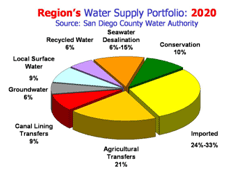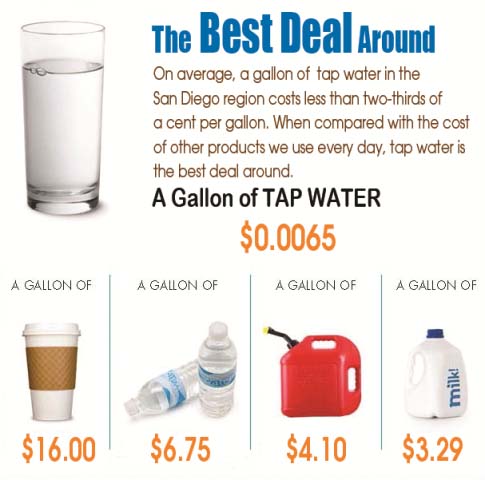Good planning is the key to meeting the future water needs of a large and diverse community. The mission of the Otay Water District is to provide high value water and wastewater services to customers in a professional, effective and efficient manner.
With limited natural water resources and less than 10-inches of average annual rainfall, San Diego County must rely on water imported from other areas of the state and the Colorado River to supply its annual demand.
The Otay Water District purchases water from the San Diego County Water Authority (SDCWA), a public agency that operates as a wholesale water supplier in San Diego County. Much of this water is in turn purchased from the Los Angeles-based Metropolitan Water District of Southern California (MWD), another public agency that imports water from both Northern California (through the State Water Project) and the Colorado River. From these sources, MWD supplies approximately 19 million residents in six Southern California counties. In addition to purchasing drinking water from the SDCWA, the District purchases drinking water from the Helix Water District and the City of San Diego.
|
The population of the District's service area has grown dramatically since it was established by voters back in 1956. The District responded to the challenge by closely following its long-range Strategic Business Plan and providing the infrastructure network and services needed to serve a large and changing customer base.
To ensure customers always have an ample water supply, the District has actively worked to continue diversifying its water resources. This includes collaborating with neighboring water agencies, investigating local groundwater aquifers, supporting efforts to develop ocean water desalination, supporting agricultural to urban water transfers, promoting conservation and the use of recycled water.
|
 |
The Otay Water District is a recognized leader in the use of recycled water for irrigation. The District's Ralph W. Chapman Water Recycling Facility produces more than one million gallons per day of high quality recycled water. The District also purchases up to another six million gallons per day of recycled water from the City of San Diego's South Bay Water Reclamation Plant. This recycled water is used to irrigate golf courses, parks and open space in eastern Chula Vista.
Water conservation will always be a high priority and the District has put into practice a wide-range of cost-effective solutions for homes and businesses. The District is also founding sponsor of the award-winning Water Conservation Garden. Located on the campus of Cuyamaca College in Rancho San Diego, this 5-acre plus demonstration garden illustrates the many ways water-conserving landscapes can be achieved economically and beautifully.
These are just a few of the ways the Otay Water District is working for the future, serving the community, and making the most of the region's precious water resources.
Tap Versus Bottled Water: The Truth About Tap
 |
Bottled water has been a successful industry for many years. In today's environmental and economically sensitive times, more people are realizing each day that tap water is the best deal around, especially taking into consideration bottled water's high cost and growing impact to the environment, including its large carbon footprint.
There are many reasons why consumers have turned to bottled water. With the busy lives we lead, many appreciate bottled water's convenience and portability, while other people keep it in stock for emergencies. Some consumers also perceive bottled water as more pure or even safer to drink than tap water. Local studies have also shown that most people in San Diego County say they prefer the taste of bottled water.
|
Links:
www.drinktap.org
Where Does My Water Come From?
Perception: Bottled water is more pure and safer to drink
Truth: In the vast majority of cases, both bottled water and tap water are safe, healthy choices. As a customer of the Otay Water District, please be assured the water coming from your tap meets all the stringent regulations of the State of California and those required by the Environmental Protection Agency (EPA) under the Safe Drinking Water Act. Bottled water is regulated through the Food and Drug Administration and is required to meet the same high standards as tap water.
If you would like to know specifically what is in your tap water, each year we deliver to your home and business a water quality report called the annual Consumer Confidence Report. A copy of this report can be viewed or downloaded under the Home/Publications tab on this website.
Perception: Bottled water is pure and comes from pristine sources
Truth: It is often true that bottled water, many marketed with images of glaciers or mountain springs, is simply repackaged tap water. Research estimates that 25% - 45% of bottled water on the market is simply filtered and packaged water from a municipal supply. Yet bottled water can cost upwards of 500 times more than tap water.
What can you do?
Tip #1: To enhance the taste of tap water, one simple suggestion is to leave an open pitcher in the refrigerator overnight. Using the chilled water with a refillable water bottle or thermos provides an inexpensive way to achieve the convenience, portability and refreshing taste of bottled water, but at a more affordable price.
Using refillable plastic bottles or thermoses will reduce the number of plastic bottles ending-up in area landfills and the environment. This practice will also help reduce the amount of petroleum needed to create millions of plastic bottles each year as well as reduce the amount of energy needed to transport those bottles to the marketplace.
Tip #2: Filter your own water at home. This can range from an inexpensive container with an activated charcoal filter, an under counter reverse osmosis system, to the installation of a full-home water filtering system. These options are each convenient, easy to use and enhance the taste of your tap water. They achieve the same desired result, while still costing a fraction of the price of bottled water. For more information on California state certified water filtration systems, please visit the California Department of Public Health's website.